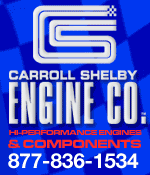 
 Main Menu
Main Menu
|
 Nevada Classics
Nevada Classics
|
 Advertise at CC
Advertise at CC
|
 February 2025
February 2025
|
| S |
M |
T |
W |
T |
F |
S |
| |
|
|
|
|
|
1 |
| 2 |
3 |
4 |
5 |
6 |
7 |
8 |
| 9 |
10 |
11 |
12 |
13 |
14 |
15 |
| 16 |
17 |
18 |
19 |
20 |
21 |
22 |
| 23 |
24 |
25 |
26 |
27 |
28 |
|
|
 CC Advertisers
CC Advertisers
|
|

05-28-2005, 02:14 AM
|
|
CC Member

|
|
|
Join Date: Feb 2002
Location: Camarillo,
CA
Cobra Make, Engine: To be determined
Posts: 9
|
|

 Not Ranked
Not Ranked
 Single Pattern vs. Dual Pattern Cams
Single Pattern vs. Dual Pattern Cams
I've noticed that most of the major cam manufacturers (Crane, Comp, etc.) list SINGLE pattern cams for the FE. I assume they've done their homework and feel that the FE doesn't respond very well to a dual pattern cam for most applications. I know some of you guys are running dual pattern cams, and was wondering if you've come across some evidence to the contrary.
|
-
Advertising


05-28-2005, 03:58 AM
|
|
Senior Club Cobra Member

|
|
|
Join Date: Jul 2002
Cobra Make, Engine:
Posts: 15,712
|
|

 Not Ranked
Not Ranked

Dual pattern cams were the "in" thing a few years ago because head/valve flow cfm on the exhaust side of things was not up to the head flow standards commonly used today. The dual pattern typically has higher lift/duration on the exhaust side to help the out flow where it WAS needed most. RV and Truck use were common applications (torque and gas mileage).
But todays heads flow pretty well on the exhaust side so the TREND is going back to single pattern cams. BUT this assumes your talking MODERN stuff, AFR, Twisted Wedge, possibly some Edelbrocks, etc!
As far as the FE is concerned: Keith Craft recently posted the old medium riser iron heads flow just about the same as a Shelby/Edelbrock head "out of the box". I've noticed that among the FE heads, in general, the exhaust ports SEEM to be pretty close to the same size. It's the INTAKE ports that very a LOT from the typical medium riser to the HUGE (in comparison) High Riser ports. But even on the high riser heads the exhaust ports aren't "that big".
We need some flow numbers here! DO the iron medium riser, Shelby and Edelbrock heads (out of the box) flow ENOUGH on the exhaust side or would they flow more with a dual pattern cam? Amazing to me that a 1964 High Riser Iron head "out of the box" is about as good as it gets unless your doing some serious port work to modern heads! And an old iron medium riser is right up there with todays best! Could they be even better with a dual pattern? Or would the money be better spent on "port" work instead? Without hard core flow numbers I doubt we will find a definitive answer.
Comp Cam 282S single pattern is what I'm running. Good to 6000-6200 and then falls off sharply. I kind of miss my old roller cam good to 6500 and beyond (but the low end wasn't so good).

|

05-28-2005, 10:11 AM
|
|
CC Member

|
|
|
Join Date: Feb 2002
Location: Camarillo,
CA
Cobra Make, Engine: To be determined
Posts: 9
|
|

 Not Ranked
Not Ranked

Quote:
Originally posted by Excaliber
Dual pattern cams were the "in" thing a few years ago because head/valve flow cfm on the exhaust side of things was not up to the head flow standards commonly used today. The dual pattern typically has higher lift/duration on the exhaust side to help the out flow where it WAS needed most. RV and Truck use were common applications (torque and gas mileage).
But todays heads flow pretty well on the exhaust side so the TREND is going back to single pattern cams. BUT this assumes your talking MODERN stuff, AFR, Twisted Wedge, possibly some Edelbrocks, etc!
As far as the FE is concerned: Keith Craft recently posted the old medium riser iron heads flow just about the same as a Shelby/Edelbrock head "out of the box". I've noticed that among the FE heads, in general, the exhaust ports SEEM to be pretty close to the same size. It's the INTAKE ports that very a LOT from the typical medium riser to the HUGE (in comparison) High Riser ports. But even on the high riser heads the exhaust ports aren't "that big".
We need some flow numbers here! DO the iron medium riser, Shelby and Edelbrock heads (out of the box) flow ENOUGH on the exhaust side or would they flow more with a dual pattern cam? Amazing to me that a 1964 High Riser Iron head "out of the box" is about as good as it gets unless your doing some serious port work to modern heads! And an old iron medium riser is right up there with todays best! Could they be even better with a dual pattern? Or would the money be better spent on "port" work instead? Without hard core flow numbers I doubt we will find a definitive answer.
Comp Cam 282S single pattern is what I'm running. Good to 6000-6200 and then falls off sharply. I kind of miss my old roller cam good to 6500 and beyond (but the low end wasn't so good).
|
I've always assumed that generally, most engines need some help on the exhaust side and therefore benefit from a dual-pattern cam (with more exhaust duration/lift). However, single pattern cams seem to be very popular on some motors, plus I do see some exceptions to this rule; some cams actually feature more INTAKE duration/lift than on the exhaust side. It sometimes makes me wonder if cam manufacturers often jump on the dual-pattern cam "bandwagon" because they think that's what sells. Then there's also the possibility this is such an inexact science, that nobody really knows what the h*ll they're doing.
If the Shelby or Edelbrock heads don't flow all that well, are there alternatives? You mentioned AFR; does AFR make an FE head? As you can tell I'm still learning about FE's but I do know AFR makes some great flowing Chevy (whoops!) LS1/LS-6 heads.

|

05-28-2005, 12:05 PM
|
|
Senior Club Cobra Member

|
|
|
Join Date: Jul 2002
Cobra Make, Engine:
Posts: 15,712
|
|

 Not Ranked
Not Ranked
I don't know that you could say the new alloy FE heads "don't flow that well", perhaps you could say the old iron heads were pretty darn good! 
Of course the alloy heads offer a major weight reduction and Edelbrock and Shelby are the only modern alloy heads I'm aware of for the FE. Cam profiles are about as scienctific as it gets, very complex stuff. Thats why it's difficult to reach a conclusion on the matter without hard numbers. Which in the case of the FE are simply not available, like the data is for so many other "typical" modern motors.
Last edited by Excaliber; 05-28-2005 at 12:12 PM..
|

05-29-2005, 06:29 AM
|
|
CC Member

|
|
|
Join Date: Sep 2003
Cobra Make, Engine: Early 427 car
Posts: 589
|
|

 Not Ranked
Not Ranked
 Heads, cam
Heads, cam
nm .
Last edited by Byots; 05-28-2018 at 06:27 AM..
|

05-29-2005, 10:27 AM
|
|
Senior Club Cobra Member

|
|
|
Join Date: Jul 2002
Cobra Make, Engine:
Posts: 15,712
|
|

 Not Ranked
Not Ranked

Good stuff Byots!
I found the quote from Keith Craft for additional data on the subject. The original question was about C8AE-H heads (390-428?).
"The Edelbrock and Shelby heads are better than the stock type type heads such as the ones you listed. The stock 427MR heads can be made to work real well and are a little better than the Edelbrocks out of the box, this is why we port them. The High Riser head is a real good head and can be made a lot better with work like fillling the floor on the intake and porting. We have done some HR stock heads that we have ported and filled the exhaust and intake floors and got 380 intake and 260 exhaust. The problem is it cost a lot of money and people just go to the aftermarket heads unless the rules do not allow such as in NHRA Super Stock."
I've heard (many times) that the MR heads were "almost as good" as the High Riser heads. High Risers don't have the exhaust cross over to warm the intake, which would make them much less "street friendly" in cold climates, and they require a matching High Riser intake manifold. My guess is that up to 6000 rpm or so it's probably true the MR vs HR are fairly equal in performance, after that you might want the HR, Tunnel Port, etc.
Last edited by Excaliber; 05-29-2005 at 10:40 AM..
|

05-29-2005, 09:21 PM
|
|
CC Member

|
|
|
Join Date: Mar 2003
Location: Arkadelphia, AR,
AR
Cobra Make, Engine: Kirkham 427 brushed aluminum with Keith Craft 527C.I. all aluminum FE
Posts: 992
|
|

 Not Ranked
Not Ranked
When it comes to camshaft design several things have to be considered and I am not sure we can get into all of them. In most cases you will see a larger exhaust duration than intake duration. This even becomes more common on larger cubic inch engines and as the rpm goes up. This does depend on the head and flow as well. There are very few cases where an engine will not benefit from a larger exhaust duration camshaft. We will run more lift a lot of times on the intake than the exhaust. The stock small block Chevy head in some cases is the one head that will run the same duration or even more on the intake side because the exhaust was so good and the engines had a real restricted intake as well. It is not uncommom to run between 8 to 12 degrees more exhaust duration on the exhaust of a FE engine. Good luck, Keith Craft
__________________
Keith C
|

05-29-2005, 09:29 PM
|
|
Senior Club Cobra Member

|
|
|
Join Date: Jul 2002
Cobra Make, Engine:
Posts: 15,712
|
|

 Not Ranked
Not Ranked
Keith what dual pattern cam would you recommend for an FE, pump gas, streetable, 6000 rpm range or so. In other words nothing to "radical".
As the exhuast ports SEEM to be the same size for MR and HR heads (low riser too?) dual pattern would seem to be a logical choice for this engine. With emphsis on the exhaust side.
Last edited by Excaliber; 05-29-2005 at 09:40 PM..
|

05-29-2005, 10:15 PM
|
|
CC Member

|
|
|
Join Date: Mar 2003
Location: Arkadelphia, AR,
AR
Cobra Make, Engine: Kirkham 427 brushed aluminum with Keith Craft 527C.I. all aluminum FE
Posts: 992
|
|

 Not Ranked
Not Ranked
I am not sure if you are running the High Riser or Medium riser heads but in a street engine with a 4 speed and a rear gear in the 3.50 to 3.91 gear I would think something like 236/244 on a 110 to 112 depending on the weight of the car and options. If flat-tappet the lift would be in the .600 lift range minus lash. I could look at some notes from previuos builds and compare to your application but I would need to know the cubic inches, car weight and induction used. Thanks, Keith Craft
__________________
Keith C
|

05-29-2005, 10:56 PM
|
|
Senior Club Cobra Member

|
|
|
Join Date: Jul 2002
Cobra Make, Engine:
Posts: 15,712
|
|

 Not Ranked
Not Ranked
I'm meant the question to be more generic, but perhaps a "generic" answer is impossible given the variables for cam design!
But lets take what might be a typical application. 2600 pound car, 3.50 (or HIGHER) rear axle, top loader and FE (390-427-428), flat tappet, street use with a "lumpy" idle. In general would a dual pattern cam work better with this scenario than a single pattern? Lets use the more common medium riser, iron or alloy head.
I think most folks running a top loader seldom go below a 3.50 rear ratio (or wish they hadn't). 
"Not Yet",,,,, but soon? Hows that Kirkham build coming along?
Last edited by Excaliber; 05-29-2005 at 11:05 PM..
|
 Posting Rules
Posting Rules
|
You may not post new threads
You may not post replies
You may not post attachments
You may not edit your posts
HTML code is Off
|
|
|
All times are GMT -7. The time now is 05:40 PM.
|





















 Linear Mode
Linear Mode



